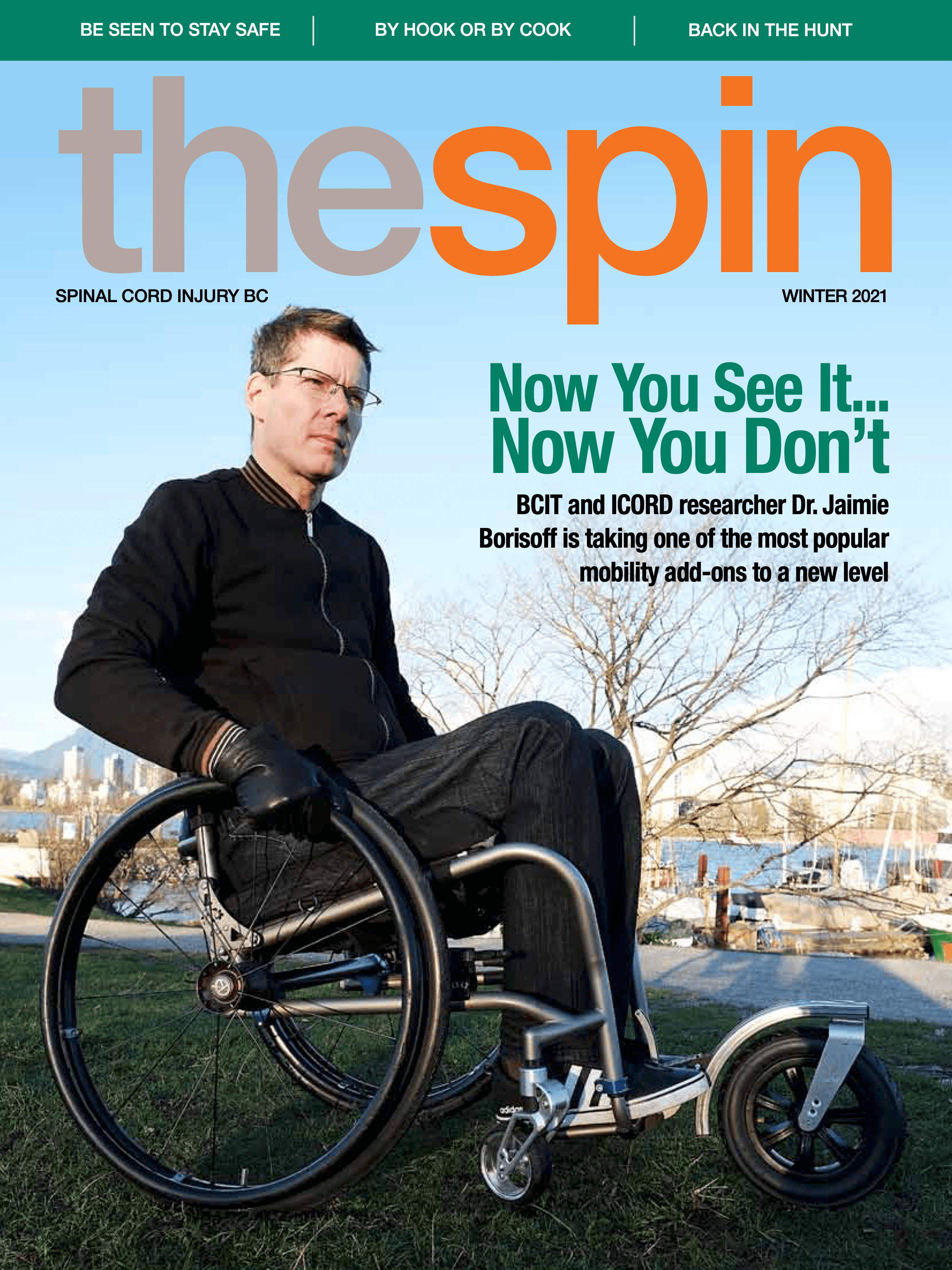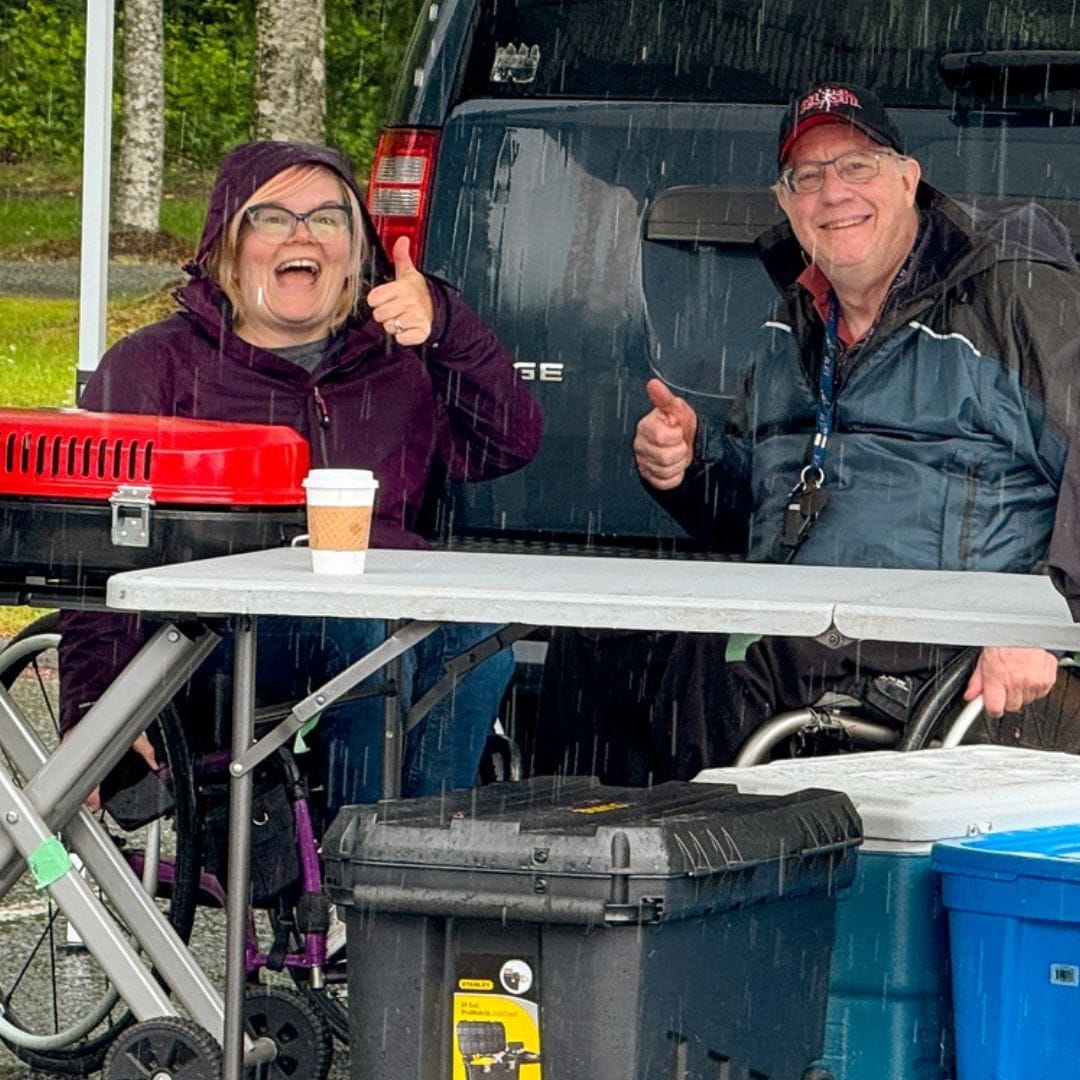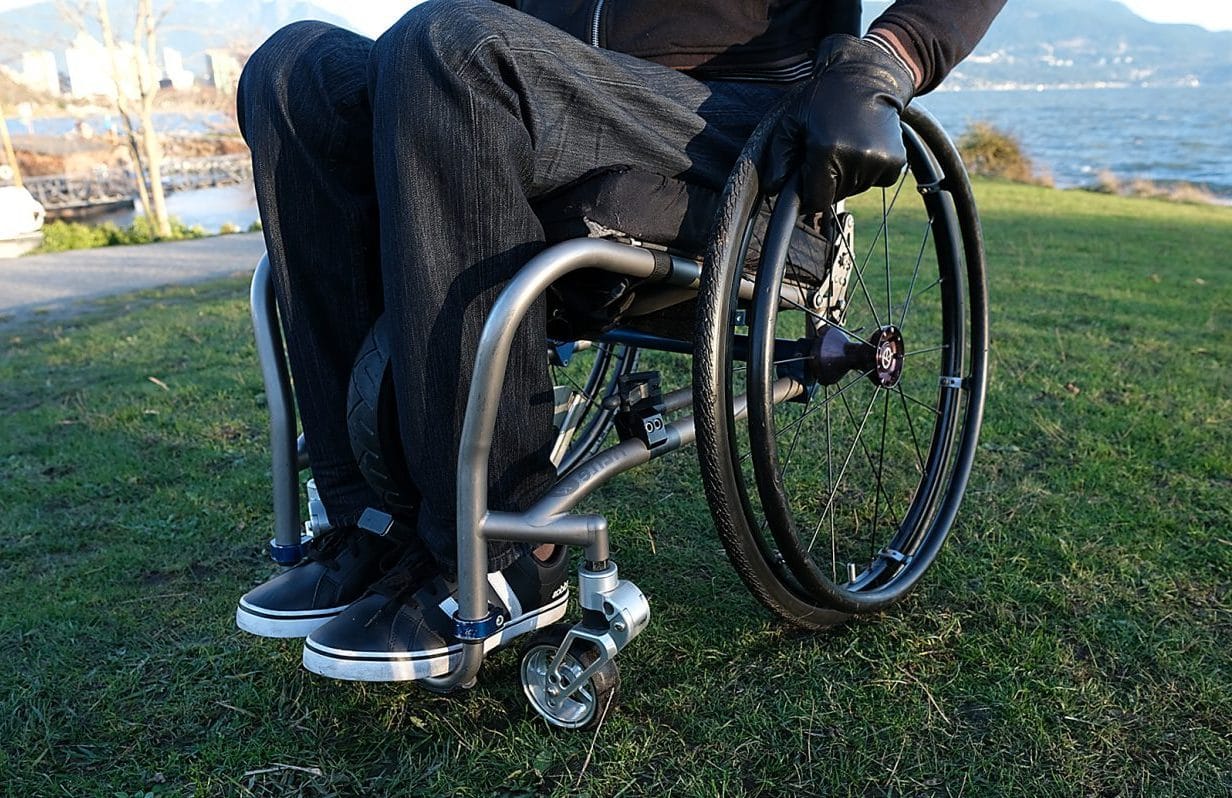
Bert Abbott loves his FreeWheel. Like so many other peers, he relies on it whenever he needs to wheel off-road (or off-sidewalk). Once locked into place, the device’s huge front wheel extends the wheelbase of his chair and lifts his front casters off the ground, making it that much easier for him to negotiate difficult terrain.
“I’ve had my FreeWheel for close to ten years,” says Abbott, who is SCI BC’s Peer Program Manager and Information Resources Agent. “It’s been very important—especially on grass soccer fields where I’ve watched my granddaughters playing soccer… [or] on trails and the beach, at outdoor concerts, and during most outdoor activities.”
Limitations of Current Wheel Attachments
But despite being a huge fan of the FreeWheel, Abbott, like many other peers who use it, says it’s not a perfect solution. Among the complaints is that it’s a little too large—and as a result, you often have to take it off when you get to your destination. At that point, it becomes a cumbersome piece of kit that you have to lug around on your lap or hang off the back of your chair. For these reasons, it’s a little inconvenient for everyday use, and often gets left at home or in the car.
“I have my FreeWheel in my car all the time in case I want to use it,” says Abbott. “But I cannot count how many times I’ve been somewhere and not put it on because I didn’t think I would need it—and then had to go back to the car to get it because it turned out that I did need it. Also, I use the FreeWheel a lot in public, and it often trips people around me, because of the length it sticks out as well as the fact that people just aren’t looking for it.”
Enter Dr. Jaimie Borisoff—an engineer and neuroscientist who is the Canadian Research Chair in Rehabilitation Engineering Design at BCIT, an ICORD principal investigator, and an adjunct professor at UBC’s Department of Occupational Science and Occupational Therapy.
Many will likely remember that he’s the inventor of the Elevation, a wheelchair now sold by PDG Mobility which simply and easily allows a user to “elevate” up to 10 inches. Most recently, we told you about the work he’s done to create aRow, an accessible rowing machine for wheelchair users.
Like Abbott, Borisoff loves the FreeWheel concept—but has long lamented its shortcomings. So he decided he could create a new add-on product.
“This is an idea that’s been slowly germinating for a few years,” says Borisoff. “I’ve always been a big fan of the FreeWheel, and even had one of the first ones made about 12 years ago. My colleague Ian Denison, who has been the equipment specialist at GF Strong for 40 years, likes to say that ‘casters are parasites’ and are only useful to stop you from tipping over. Otherwise, they just dig into stuff, get stopped by rocks and bumps, and can even pitch you forward dangerously. Of course you need casters for the best indoor manoeuvrability and to keep you from tipping over. But if you can get rid of the need for casters when appropriate, using a device like the FreeWheel, it offers some big benefits.”

Dr. Borisoff Creates the SWIVL
Borisoff played around with a few ideas for years. Then, in September 2020, Dr. James Laskin, who works at the Praxis Spinal Cord Institute, asked him if he had anything on the burner that might be a good candidate for the Praxis SCI Incubate program, which helps commercialize technology designed to improve life for people with SCI and other disabilities.
“He thought I must have something kicking around that would be appropriate,” says Borisoff. “This was about 10 days before the deadline for submissions. And I thought, ‘Hmm…you know, there is this thing.’”
At the time, the “thing” was still just an idea in Borisoff’s head. But the prospect of getting funding—and the looming deadline for applications—lit his fire.
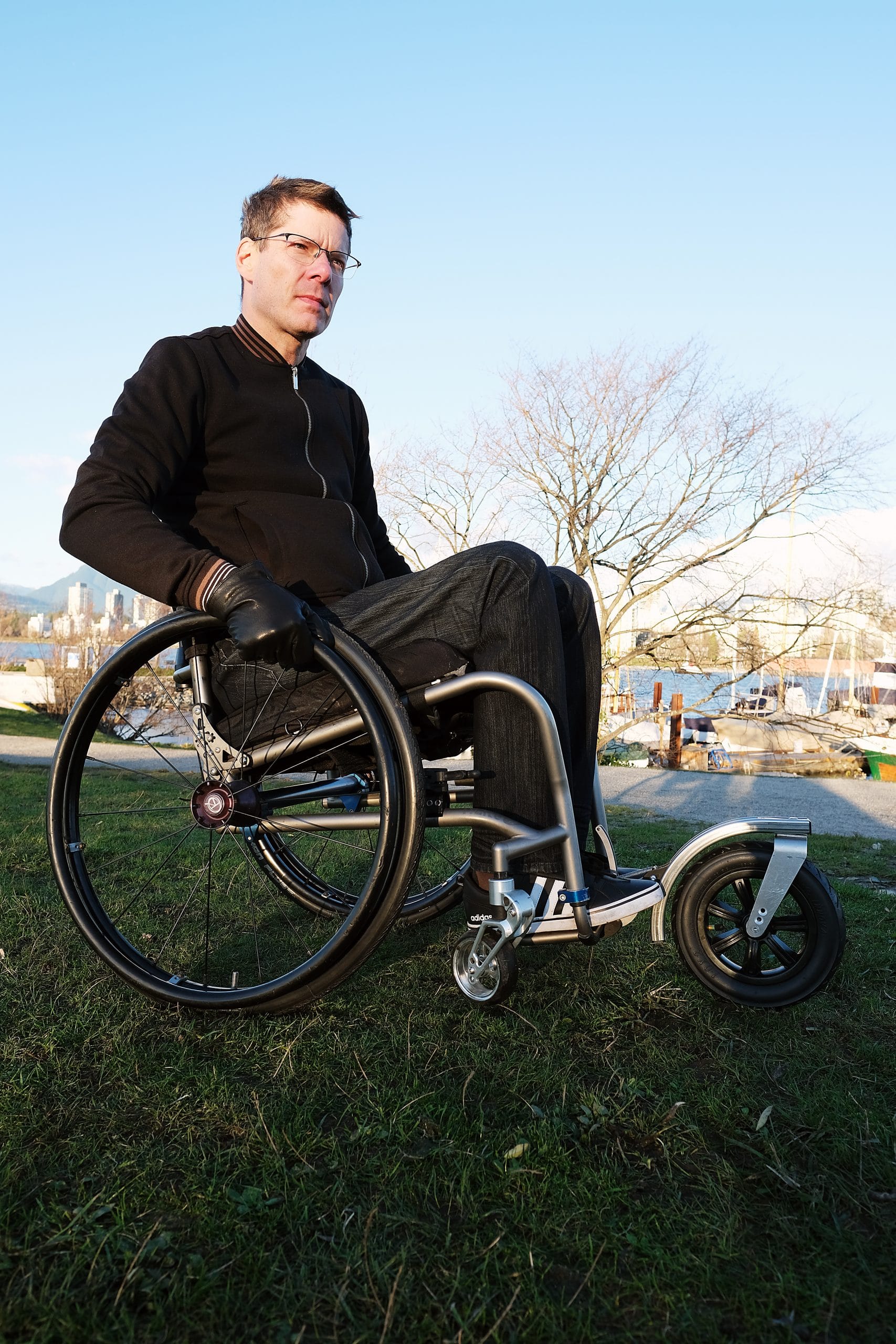
“When things kicked into gear, I was, in the back of my mind, considering the space underneath the front of a manual wheelchair, between your legs and rear axle. It’s a lot of space and generally underutilized. I also had an increasingly clear idea of what was wrong with the FreeWheel and all products like it—you often don’t have it with you when you need it! Great product, but if it sits at home all the time like mine, not being used, that’s a problem, right? They also don’t store well, and are difficult to carry … So I had this idea: what if you could tuck, fold, or place a FreeWheel-like thing under your chair, and easily deploy it when needed?”
With just a week and a half before the Praxis deadline, Borisoff got to work on a prototype.
“I did a lot of the work at home, after an initial trip to get all sorts of bits and pieces from my lab shelving units. A wheel here, a fork there. I even used a piece of my kid’s Lego as a spacer. I submitted an application and prototype on time, along with a video showing the prototype with me using it outside—it was pretty cool.”
That prototype was built with the wheel stored under the chair on a swinging arm. To activate it, the user would do a wheelie—the wheel would swing down, and momentum would carry it to the front of the chair, where the footrest locked it into place.
“It turned out to be relatively easy to build this simple prototype,” says Borisoff. “And it just worked. It swung like a pendulum when you did this extreme wheelie, and it emerged, and as you landed the wheelie, bam! The casters were up and away you went. Then you did a big wheelie again, and it tucked right back where it didn’t bother you when it was stowed, and you could start wheeling again.”
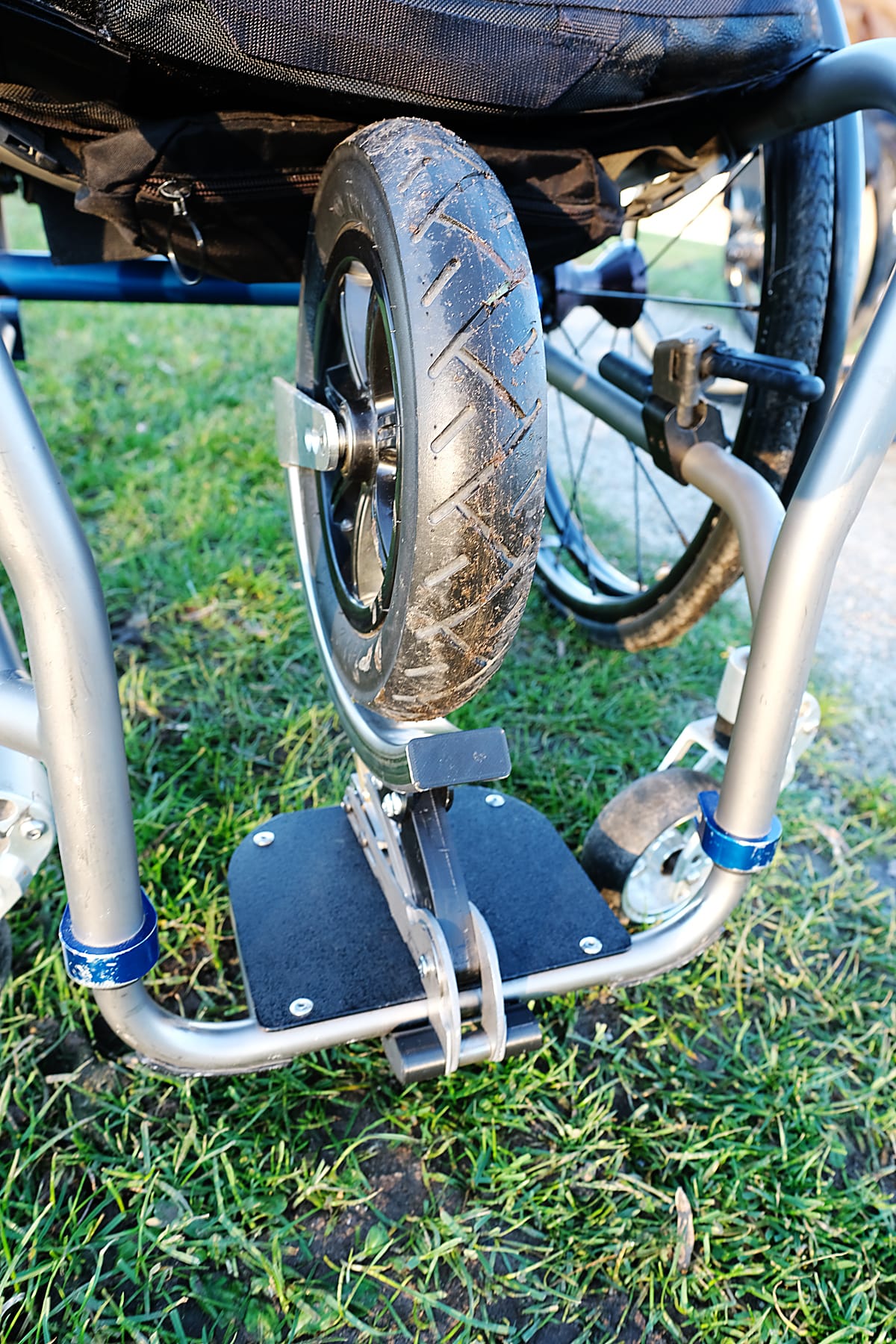
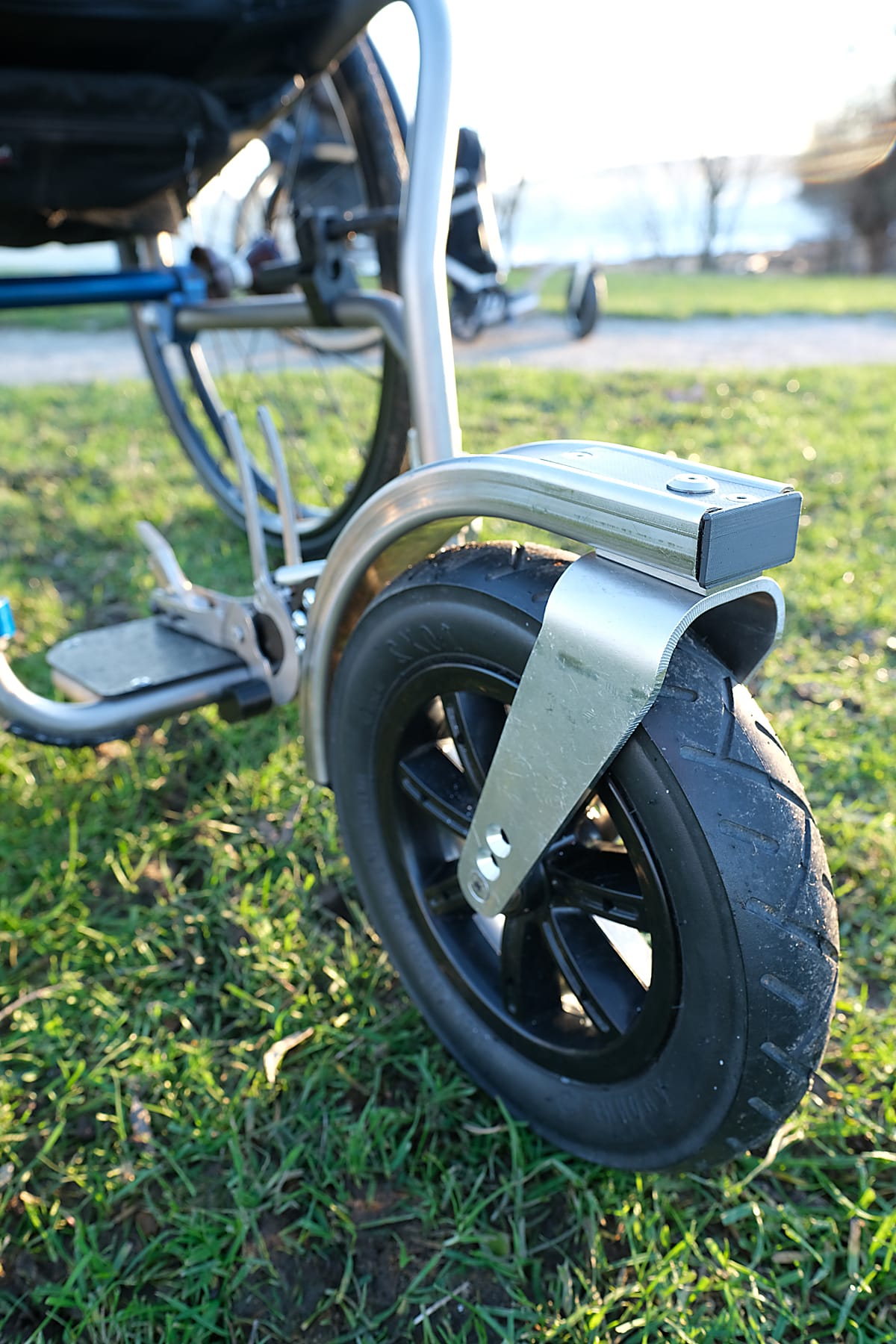
The application process for Praxis SCI Incubate program had several stages. After demonstrating the prototype at his first interview, Borisoff was invited for a second interview, two weeks after the first. In the interim, he realized he needed to make some changes.
“It became obvious that the kung-fu wheelie thing was a bit extreme,” he explains. “So I decided it needed to be easier to fold out and stow again. It had to come out from between your legs. I made a second prototype where the wheel was stored between the legs, and deployed by swinging it out and down. Like the first prototype, it worked great, but the difference was that it was now very easy to use.”
The revised design won over the Praxis staff, and the SCI Incubate program approved it.
“With funding in place, we started real development of the product,” says Borisoff. Over the next six months, with help from BCIT’s MAKE+ applied research team, he worked on refining the concept. He tested different sizes of the wheel. He added the ability for the wheel to swivel. He worked on adjustability so it would fit a wide variety of wheelchairs. He beefed up the strength, and improved the clamping and locking-in-place mechanisms. And, perhaps most important, he increased the rigidity to avoid the type of “flutter” that some users experience with the casters of their chairs.
He dubbed it the SWIVL, and started to refer to it as “the stow and roll front wheel.” Users can easily attach the SWIVL themselves while they’re sitting in their wheelchair. When not in use, it’s folded up and between the legs of the user (or even further behind the legs, depending on the wheelchair frame). It’s deployed in seconds by “swivelling” it out and, with a simple click to lock it into place, the casters are lifted off the ground. In just seconds, users can shift easily between the SWIVL and regular castors as needed.
A Marketable Prototype is Introduced
By this past summer, Borisoff felt he finally had a polished prototype—one that he could confidently seek a patent and trademark for in order to protect his intellectual property. Then, with those applications submitted, he began the process of seeking validation from both peers and colleagues in the world of mobility engineering.
He began testing it with peers, who provided overwhelmingly positive feedback. Buoyed by that, he presented it in July at the 2021 RESNA conference (RESNA is the Rehabilitation Engineering and Assistive Technology Society of North America) and won the prestigious Developer’s Showcase IMPACT Award.
“All validation is important,” he says. “Not just for me, but also for potential partners who may help me bring this to market—they want validation from as many others as possible. Of course, real sales are even better validation, but I believe we’ll get there as we move forward.”
As you read this, Borisoff is in the process of exploring ways to bring the device to market as soon as possible. Options include fabricating a modest number of SWIVLs and getting them on the market, or enlisting the help of an industry partner. He’s grateful to the Praxis SCI Incubate program for providing him with the expertise and advice he needed to start this process, in addition to the $25,000 of seed money.

While the business aspect of bringing SWIVL to market is a chore to him, personally using the device on a regular basis has been nothing but a pleasure.
“I’ve been using it when my kids play baseball,” he says. “I used it on Halloween night—it made trick or treating with my kids a breeze. No problem with sidewalks full of wet leaves, or wheeling over grass and even a path through bushes. When we got to an area with dozens of people milling around in front of a particularly cool decorated house, I thought, ‘Someone is going to trip over this thing.’ Duh! I just tucked it up; problem solved. And then we went to a neighbour’s house. As we went through their front door, I just folded it up, and voila. When we left, down it came again for the wheel home. Once it’s attached, it works like a charm.”
Looking forward, Borisoff’s ultimate hope for SWIVL is to have mobility therapists offer it as an add-on as a matter of course for every manual wheelchair prescribed and sold.
“It’s about wheelchair users being able to live more spontaneously; being able to access whatever environment they want, whenever they want,” he says. “This notion of spontaneity is key and usually ignored. People with disabilities can do almost anything if they have the right equipment, resources, and assistance from others. But they often can’t do things on a whim like everyone else.”
The last word goes to Bert Abbott, who hasn’t tested the prototype, but has seen the video Borisoff created to debut the SWIVL at the 2021 RESNA conference.
“This does sound and look like a great product and is an improvement on the FreeWheel,” he says. “It’s a great idea. Having it fold up, and being able to have it on your chair all the time, is the best part of the product. Overall, if I had seen this product before the FreeWheel, I probably would have chosen it. And should I need a new one in the future, I will most likely choose the SWIVL if it’s available.”
This article was originally published in the Winter 2021 issue of The Spin. Read more stories from this issue, including:
- Be Seen to Stay Safe
- By Hook or by Cook
- Back in the Hunt
And more!
